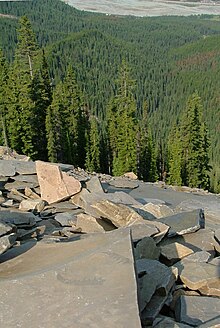Mount Stephen trilobite beds
 From Wikipedia - Reading time: 6 min
From Wikipedia - Reading time: 6 min
| Part of a series on |
| The Burgess Shale |
|---|
 |
The Mount Stephen trilobite beds (UNSM locality 14s)[1] are a series of fossil strata on Mount Stephen, British Columbia that contain exceptionally preserved fossil material. Part of the same stratigraphic unit as the Burgess Shale deposit, many non-mineralized parts (such as anomalocarid claws, sponges, and trilobite legs) are preserved; in addition, a high density of trilobite fossils is present.
History
[edit]The trilobite beds were the first Burgess shale locality to be discovered.[2]
The richness of fossils in the Field area was first identified by workers associated with the construction of the Trans-Canada railway, which had (somewhat controversially) been routed through the Kicking Horse valley.[3] Richard McConnell, of the Geological Survey of Canada, was pointed to the beds by a railway worker whilst mapping the geology around the railway line in September 1886.[4] Several unusual fossils were subsequently described from this site, including sponges, worms,[5] and the appendages of the unusual Anomalocaris, identified at that time as the bodies of crabs.[6] These fossils prompted Charles Doolittle Walcott to make forays into the area, and led to his discovery of the Walcott Quarry on Fossil Ridge.
Stratigraphy
[edit]The trilobite beds are in the Campsite Cliff member, and contain the marker trilobite Ogygopsis.[7]
Location
[edit]
The strata are located on Mount Stephen in British Columbia.
References
[edit]- ^ Conway Morris, Simon; Robson, R.A. (1988). "More soft-bodied animals and algae from the Middle Cambrian of Utah and British Columbia" (PDF). University of Kansas Paleontological Contributions. 122: 1–48.
- ^ Collins, D. (July 1, 2009). "A Brief History of Field Research on the Burgess Shale". In Caron, Jean-Bernard; Rudkin, David (eds.). A Burgess Shale Primer—History, Geology and Research Highlights. The Burgess Shale Consortium. pp. 15–32. ISBN 978-0-9812885-0-5.
- ^ Collins, Desmond (August 2009). "The Discovery of the Burgess Shale Site on Fossil Ridge, British Columbia" (PDF). In Smith, Martin R.; O'Brien, Lorna J.; Caron, Jean-Bernard (eds.). Abstract Volume. International Conference on the Cambrian Explosion (Walcott 2009). Toronto, Ontario, Canada: The Burgess Shale Consortium (published 31 July 2009). ISBN 978-0-9812885-1-2.
- ^ Collins, D. (Aug 2009). "Misadventures in the Burgess Shale". Nature. 460 (7258): 952–953. Bibcode:2009Natur.460..952C. doi:10.1038/460952a. ISSN 0028-0836. PMID 19693066. S2CID 27237547.
- ^ Matthew, G.F. (1899). "Studies on Cambrian Faunas, No. 3.—Upper Cambrian Fauna, Mount Stephen, British Columbia.—The Trilobites and Worms". Philosophical Transactions of the Royal Society. 5: 39–68.
- ^ Whiteaves, J.F. (October 1892). "Description of a new genus and species of Phyllocarid crustacean from the Middle Cambrian of Mount Stephen, B.C.". The Canadian Record of Science. 5 (4).
- ^ Caron, J.-B.; Scheltema, A.; Schander, C.; Rudkin, D. (2006). "A soft-bodied mollusc with radula from the Middle Cambrian Burgess Shale" (PDF). Nature. 442 (7099): 159–163. Bibcode:2006Natur.442..159C. doi:10.1038/nature04894. hdl:1912/1404. PMID 16838013. S2CID 4431853.
 KSF
KSF
